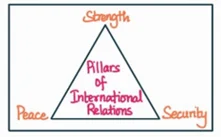UPSC CSE : 2017
Answer:
| Approach:
Introduction
Body
Conclusion
|
Introduction:
International relations refer to the interactions between nations, including diplomatic relations, trade agreements, and military alliances. These interactions are guided by various principles, or pillars, that define the relationships between nations. Three fundamental pillars of international relations are strength, peace, and security.

Body:
Strength: It refers to the ability of a nation to protect and advance its interests, maintain its sovereignty, and project its power on a global scale. Strength can be achieved through military, economic, and diplomatic means.
For example,
Peace: It refers to the absence of conflict and the presence of stability, cooperation, and harmony among nations. Peace can be achieved through diplomacy, international law, and conflict resolution.
For example,
Security: It refers to the protection of a nation’s people, territory, and interests from external and internal threats. Security can be achieved through military, intelligence, and law enforcement means.
For example,
These three pillars are interrelated and essential for stable and constructive international relations. Nations that are strong can contribute to maintaining peace and security, while peaceful and secure nations can use their resources to promote strength and stability globally.
Conclusion
As nations become more interconnected and interdependent, they will need to work together to tackle common challenges such as climate change, terrorism, and cybersecurity threats. In doing so, they will need to uphold the principles of strength, peace, and security to ensure that they can work together effectively and promote mutual benefit.
<div class="new-fform">
</div>